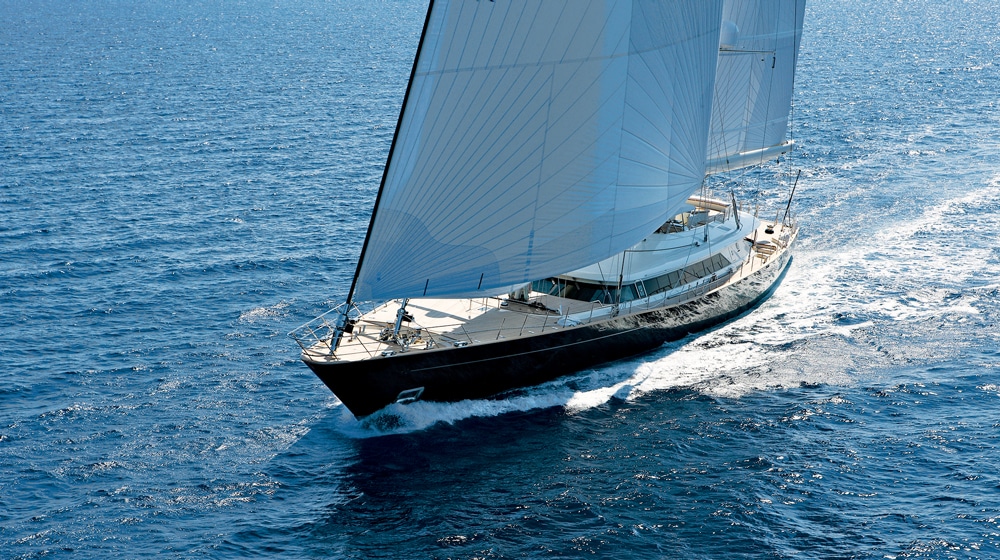
Perini Navi 184
Riding 30 feet up on the windward rail with the leeward sheerline a couple feet under water, the keel threatening to go airborne, and every inch of the rigging strained to the limits of its capability, this was a moment to remember for me. It must also have been a memory in the making for the dozens of owners and crew aboard other Perini Navis. Hundreds of spectators had gathered to enjoy the magnificent show that day, and I was enjoying the privilege of participating in the inaugural Perini Navi Cup in July 2004, racing aboard Santa Maria (now Zenji) against Burrasca, ketch-rigged sisters, and ten other big Perinis in mistral conditions off Sardinia. The regatta showcased the quality of these yachts—in both design and construction—like no other test could have. A total of 15 Perini-built superyachts, from 110 feet to 184 feet, had gathered for the regatta and 12 eventually participated in the staggered-start race.
Last fall, as I walked down the floating dock in Monaco, I instantly recognized another of the sisters—Riela—yet I’d never seen her before and really didn’t know her at all. This was the seventh build in Perini Navi’s series of 184-foot sailing yachts that began with_ Burrasca_ in 2003. That year was also the 20th anniversary of Fabio Perini’s company, located in Viareggio, Italy. In addition to series-built yachts, Perini Navi continues to offer custom designs. There are also motoryachts, built by Perini’s sister company Picchiotti. The first motoryacht of the Vitruvius line, a 164-footer, is due to launch this spring, construction of a 180-footer is well underway, and a contract has been signed for a 240-footer.
The word series is used in preference to semi-custom for these yachts, because the extent of changes from boat to boat is well beyond the norm. It is not just colors, textures, and a few arrangement details that differ, but rather almost everything except the hull and deck structure. While some early Perinis were built with steel hulls, the yachts of this series have aluminum hulls and superstructures for lighter weight and better performance.
Naval architect Ron Holland, who collaborated with Perini Navi’s technical department, refers to craft of this type as “performance cruisers,” and not without reason. It is more than a marketing term, because these comfortable yachts perhaps best display their hidden assets in a serious blow. Those in the know use still another term for series. “Limited-edition yachts offer the advantages of reduced build time and cost, a proven engineering platform, and the reassurance that the concept has been tried and tested at sea,” says Holland. “The owner retains considerable flexibility of choice over details of the accommodation, styling, and finishes.” While they share naval architecture and marine engineering, each of these yachts has been built with a different arrangement, a different interior design, and in some cases, different exterior styling and even different rigs. Burrasca and Riela are ketch-rigged, but Salute, one of the middle sisters, is a sloop.
I’ve been aboard many of the vessels in the series. The interior styles range from reserved traditional to cool modern. Riela lies somewhere in the middle. With Riela, interior designer Remi Tessier has provided us with an interesting exercise in interior design, one that is illustrative of just how flexible a yacht interior can be.
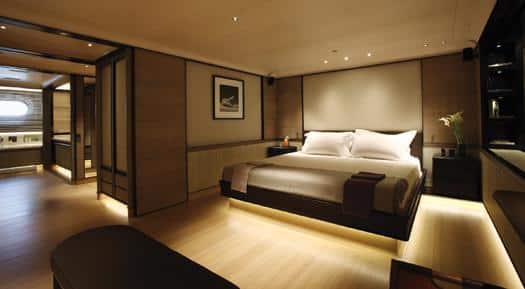
The fixed elements—the joinerwork, the bulkhead materials, the deck coverings, and the overhead—create an elegant but fairly neutral foundation that can be finished off with accessories, floral arrangements, sculpture, and hanging art to create any number of different moods with very little effort and minimal cost. A few classic sepia-tone photos, and light-colored sofas and bedding, and you have a wonderfully minimalist décor. Change the bulkhead hangings to classic gold-framed, maritime-themed oil paintings, add a few leather-bound books on the shelves, position your dried florals, swap out the soft goods with seasoned leather, and you have a reserved, traditional interior. Bring in some modern art, a few painted daisies, and some edgy furnishings, and the yacht will take on a thoroughly trendy persona.
It’s a designer’s trick that is often used, but you’ll seldom see it executed as well as Tessier has done aboard Riela. He has incorporated a variety of materials, colors, and textures to create his underlying palette, but the result is a unified appearance that works well. The overhead is figured sycamore throughout the interior and teak on the open aft deck. In both cases, it is divided with polished stainless steel accent strips through the middle and fitted with Macassar ebony at the periphery. Decks are primarily bleached teak inside and natural teak outside, and bathroom countertops are matte limestone.
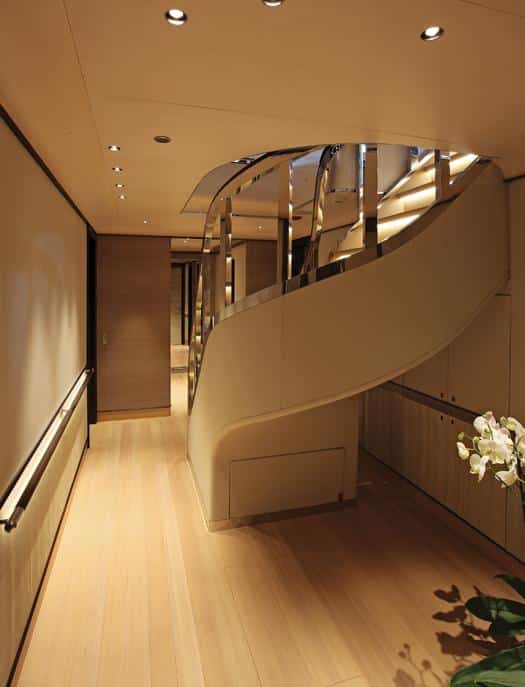
Bulkheads are bleached and brushed spruce from the deck to about one-third height and gray leather above, divided by strips of Macassar ebony and bleached wenge, and capped by ebony. Recesses for china and objets d’art are lined with bleached sycamore, and bleached wenge is utilized in many of the corner panels and door casings.
With a few exceptions, most of the furnishings are also designed by Tessier. Brown leather and cream linen fabrics are used for the custom sofas and ottomans, and the tables are ebony with polished stainless steel legs and frames. On the aft deck, Tessier has added a few touches of carbon fiber as a reminder of the structural material used in the yacht’s massive booms. Furnishings designed by others include a white leather Poul Kjaerholm armchair and a Pinel & Pinel game case in the saloon, and handmade, natural-teak Hans Wegner chairs in the dining room.
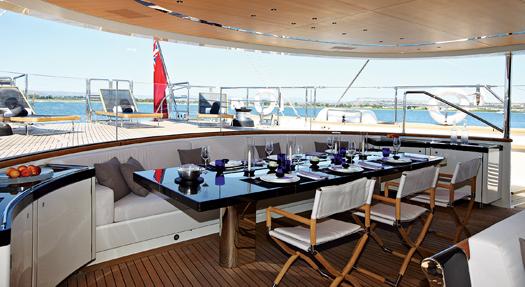
Although stabilizers have taken much of the rock and roll out of modern yachts, the truth is that they still take the occasional unexpected lurch at sea. Thus, one feature I welcomed in Tessier’s design is the near-total lack of square corners throughout the interior. After suffering through years of edgy—figuratively and literally—European interiors with enough sharp corners to cause a bloodbath among unwary guests, it was really nice to see rounded corners everywhere, whether radiused edges on bulkheads, or cove moldings on inside corners and cornices. There were a few exceptions, but for the most part, the interior is not only stylish but safe.
Riela can accommodate up to 12 guests in six en suite amidships cabins, all clustered around a central foyer on the lower deck. There are two twin-berth staterooms adjacent to the crew quarters forward and two queen staterooms just abaft the twins. A smaller cabin with upper and lower twin berths, suitable for children or the owner’s personal staff, is immediately adjacent to the master stateroom. The master stateroom, occupying the full beam of the yacht at its widest point, includes a sitting area, a small vanity, and a head with tub, shower, two lavatories, toilet, and bidet.
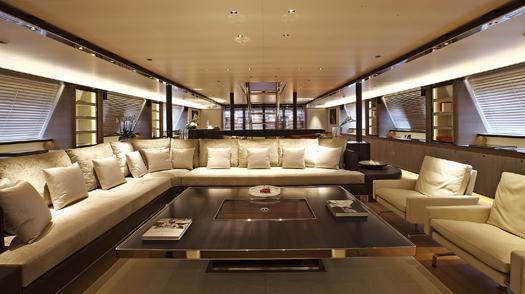
The main house, a single large space above the guest accommodations, carries the saloon and dining room, as well as a small bar, a game area, and a service galley. Aft is a covered open deck with dining and sitting areas, plus a day-head. Forward of the saloon and down a few steps is a ship’s office and navigation area. An extensive flying bridge, a signature feature on many Perini Navi yachts, covers both the deckhouse and aft deck. It carries double helm benches forward, dinette tables and benches amidships, and a whirlpool spa and lounges aft.
Perhaps inspired by the Perini Navi Cup as well as the more recent Superyacht Cup, a new “racing line” of Perini yachts designed by Philippe Briand was born with the launch of P2, a 125-footer launched late in 2008. A sister is currently under construction.
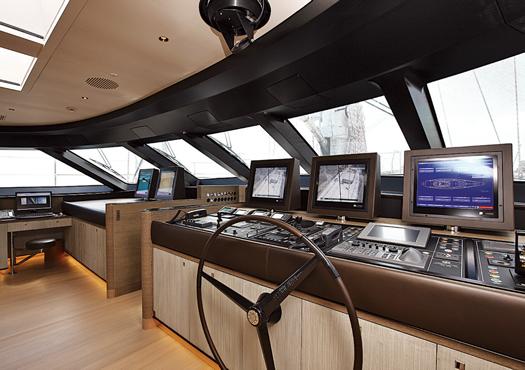
Riela, the 46th yacht in the Perini Navi fleet, is now an older sister herself. An eighth yacht in the 184-foot series, Panthalassa, was launched a couple of months after my visit to Riela. When I heard about another sister going down the ways, it brought me back to that regatta more than half a decade ago. There were a few tattered sails, some lost battens, but not a single failure of rigging, fittings, or structure. At the Costa Smeralda awards dinner that evening, held beside the Mediterranean and beneath the stars, every participant, win or lose, took satisfaction in knowing they had been party to the start of something very special. Since that inaugural regatta, there have been two more Perini Navi Cups, and extreme conditions have again tested the fleet with equally satisfying results, a continuing testimony to the dedication and skills of the Perini Navi team.
Perini Navi, + 39 0584 4241; www.perininavi.it** Perini Navi USA, (401) 683-5600**









